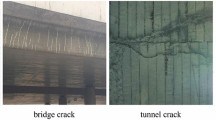Abstract
We propose a crack detection network based on an image segmentation network for robust crack detection, which utilizes information from the entire image and performs pixel-wise prediction. To overcome the lack of data, we also propose a crack image generation algorithm using a 2D Gaussian kernel and the Brownian motion process. We gathered 242 crack images from plain images to cluttered images to train and verify the robustness of the proposed crack segmentation network. To verify the usefulness of simulated cracks, we used 2 integrated datasets constructed with 100 and 200 simulated crack images added to the actual crack dataset, as well as an actual crack dataset. To derive the maximum prediction performance, the neural network was pre-trained on the MS-COCO dataset, and re-trained by each crack dataset. The results show that the proposed method is highly robust and accurate, even for complex images. The trained network was also tested under different brightness, hue, and noise conditions, and results have shown that this promising method can be used in various inspection platforms.












Similar content being viewed by others
References
Mohan A, Poobal S (2017) Crack detection using image processing: a critical review and analysis. Alexandria Eng J 57:787–798
Aboudi J (1987) Stiffness reduction of cracked solids. Eng Fract Mech 26(5):637–650
Eich M, Vogele T (2011) Design and Control of a lightweight magnetic climbing robot for vessel inspection. In: Mediterranean conference on control and automation
Lim RS, La MH, Shan Z, Sheng W (2011) Developing a crack inspection robot for bridge maintenance. In: International conference on robotics and automation
Metni N, Hamel T (2007) A UAV for bridge inspection: visual servoing control law with orientation limits. Automat Constr 17(1):3–10
Wang P, Huang H (2010) Comparison analysis on present image-based crack detection methods in concrete structures. In: 3rd International congress on image and signal processing
Ziou D, Tabbone S (1998) Edge detection techniques-an overview. Pattern Recogn Image Anal 8(4):537–559
Cha Y-J, Choi W, Buyukozturk O (2017) Deep learning-based crack damage detection using convolutional neural networks. Computer-Aided Civil Infrastruct Eng 32(5):361–378
Krizhevsky A, Sutskever I, Hinton GE (2012) ImageNet classification with deep convolutional neural networks. In: Proceedings of the 25th international conference on neural information processing systems, vol. 1, pp 1097–1105
Simonyan K, Zisserman A (2015) Very deep convolutional networks for large-scale image recognition. arXiv Preprint arXiv:1409.1556
Ren S, He K, Girshick R, Sun J (2015) Faster R-CNN: towards real-time object detection with region proposal networks. arXiv Preprint arXiv:1506.01497
Long J, Shelhamer E, Darrell T (2014) Fully convolutional networks for semantic segmentation. arXiv preprint arXiv:1411.4038v2
Zhang L, Yang F, Zhang YD, Zhu YJ (2016) Road crack detection using deep convolutional neural network. In: IEEE international conference on image processing (ICIP), pp 3708–3712
Chen F-C, Jahanshahi MR (2018) NB-CNN: deep learning-based crack detection using convolutional neural network and naïve Bayes data fusion. IEEE Trans Ind Electron 65(5):4392–4400
Wang N, Zhao Q, Li S, Zhao X, Zhao P (2018) Damage classification for masonry historic structures using convolutional neural networks based on still images. Computer-Aided Civil Infrastruct Eng 33:1073–1089
Yang X, Li H, Yu Y, Luo X, Huang T (2018) Automatic pixel-level crack detection and measurement using fully convolutional network. Computer-Aided Civil Infrastruct Eng 33:1090–1109
Clevert DA, Unterthiner T, Hochreiter S (2015) Fast and accurate deep network learning by exponential linear units (ELUs). arXiv Preprint arXiv:1511.07289
Ioffe S, Szegedy C (2015) Batch normalization: accelerating deep network training by reducing internal covariate shift. arXiv Preprint arXiv:1502.03167
Srivastava N, Hinton G, Krizhevsky A, Sutskever I, Salakhutdinov R (2014) Dropout: a simple way to prevent neural networks from overfitting. J Mach Learn Res 15:1929–1958
Maybeck PS (1979) Stochastic models estimation and control. Academic Press, Cambridge
Lin TY, Maire M, Belongie S, Bourdev L, Girshick R, Hays J, Perona P, Ramanan D, Zitnick LC, Dollar P (2014) Microsoft COCO: common object in context. arXiv Preprint arXiv:1405.0312
Yosinski J, Clune J, Bengio Y, Lipson H (2014) How transferable are features in deep neural networks? arXiv Preprint arXiv:1411.1792
Kingma DP, Ba J (2014) ADAM: a method for stochastic optimization. arXiv Preprint arXiv:1412.6980
Acknowledgements
This work was supported by the National Research Foundation of Korea(NRF) Grant funded by the Korea government(MSIT) through GCRC-SOP (no. 2011-0030013).
Author information
Authors and Affiliations
Corresponding author
Rights and permissions
About this article
Cite this article
Lee, D., Kim, J. & Lee, D. Robust Concrete Crack Detection Using Deep Learning-Based Semantic Segmentation. Int. J. Aeronaut. Space Sci. 20, 287–299 (2019). https://doi.org/10.1007/s42405-018-0120-5
Received:
Revised:
Accepted:
Published:
Issue Date:
DOI: https://doi.org/10.1007/s42405-018-0120-5




